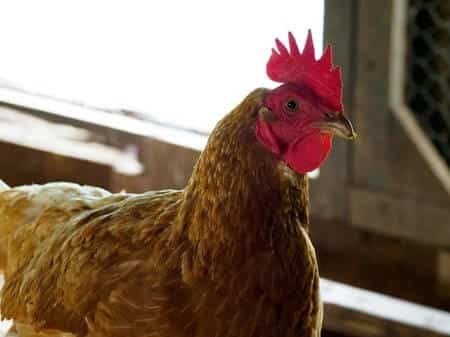The average weight and egg size of an ISA Brown egg is 63.1 grams (2.22 oz.). That means they lay large eggs, just short of extra-large according to US industry egg sizes. Don’t be surprised to see plenty of extra-large eggs from well-kept ISA Browns.
Table of Contents
What Size Eggs Do ISA Browns Lay?
ISA browns are recognized globally as one of the most prolific egg-laying varieties. They also have an exceptional feed conversion. Which in commercial egg farming terms means they are very profitable for how much it costs to feed them.
I’ve seen some slightly different average estimates for their egg weight, which is normal when messing egg sizes. But going with what ISA-Poultry says, fully mature ISA Browns’ eggs weigh 63.1 grams on average.
This puts them in the large egg category using the US egg sizing standards. They’re just short of the 63.8 gram requirement for extra-large egg classification though, so they are sometimes referred to as laying extra-large eggs.
These are numbers for commercially kept hens. I’m sure, in a backyard setting with the freedom to free-range and quality layer feed, you’re more likely to find an extra-large egg in their nesting box than a large egg.
Either way, there isn’t a lot in it in terms of weight as they are on the cult of extra-large on average. Here are the current US standards for egg sizes and weights:
US Standards and Classifications of Egg Sizes
| Name | Approx Weight |
|---|---|
| Peewee | 1.25 oz* |
| Small | 1.50 oz* |
| Medium | 1.75 oz* |
| Large | 2 oz* |
| Extra Large | 2.25 oz* |
| Jumbo | 2.5 oz* |
What Does ISA Mean in Chickens?
If you’re wondering why this type of chicken is called an ‘ISA’, you’re not alone. It’s an unusual name for a variety of chickens, but there is a logical explanation.
ISA stands for Institut de Sélection Animale, the company which developed the crossbreed in 1978. The Institut de Sélection Animale is a French company, and they developed the ISA Brown as a battery hen, so they had to name it.
Their objective was to create a chicken that would lay a high number of eggs and be inexpensive to keep, and that’s exactly what they achieved.
The ISA Group merged with Merck & Co. at some point, forming Hubbard ISA. This is why some of the other names ISA Browns are the Hubbard ISA Brown, and also just Brown, or Red sexlinks.
As far as pronouncing the name goes, now you know the initials are an acronym for the company name. So, you just say the three letters one after the other, “I S A Brown”.

What Breeds of Chicken Are Used To Make the ISA Brown?
This is what makes the ISA Brown so interesting and a little mysterious. The only people who know what breeds were used to make this crossbreed is the company that created the ISA, the Institut de Sélection Animale.
They have never publicly released the breeds and genetics they used to make the ISA. It remains a mystery to date.
Most assume that it involved the Rhode Island Red and Rhode Island Whites. They do look a lot like a Rhode Island Red, and they are also prolific layers. But as far as what the other genes are, it’s unknown.
This is why you can’t easily find genuine ISA Browns for sale. There are some poultry breeders/sellers advertising ISA Browns, but whenever I’ve looked into it, they were not the real ISA Brown.
Another thing to note, the ISA is not a breed of chicken. They are a hybrid, a crossbreed, variety, but not a defined breed.
What Color Eggs Do ISA Browns Lay?
The short answer is that ISA Browns lay brown eggs. The shade will vary, as it does with all breeds of chicken. But, generally speaking, they lay a medium to dark brown color egg (if that makes sense).
An interesting thing that rarely gets talked about is that there is an ISA White, too. These lay white eggs, as you could probably guess from their name. White eggs aren’t as popular or in such demand, so there aren’t as many ISA Whites.
Related - Here is a more detailed look at the color of egg ISA Browns lay.
What Are ISA Brown Chickens Like?
When seen in a commercial setting, ISA Brown chickens are often just seen as mass-produced brown hens.
In a backyard setting or when kept as a pet, however, they are individuals just like any chickens. In fact, they are known for being one of the friendliest and affectionate types of chicken - who doesn’t want that?
The downside is that they have a shorter life expectancy than most other popular breeds. They were created to live just 2-3 years and to produce in the range of 400-500 eggs in that time.
While their genetics plays a big part in how long they will live, as with most chickens (and other animals) the standard of care they receive will affect their lifespan.
I read plenty of accounts from owners saying their ISA’s lived as long as 5-6 years. Either way, they are a lot of fun to raise, so just give them the best possible care and enjoy every minute. That’s my advice.
Related - What is an ISA Brown’s life expectancy?
In Summary
There is no denying that ISA Browns are one of the more interesting and unique varieties of chicken.
If you were wondering what color eggs they lay; ISA Browns lay large to extra-large brown eggs, and a lot of them!
Resources
Image credits - Header photo by Erol Ahmed, ISA by Brett Jordan on Unsplash




